国际音标语音练习
- 格式:docx
- 大小:53.68 KB
- 文档页数:13
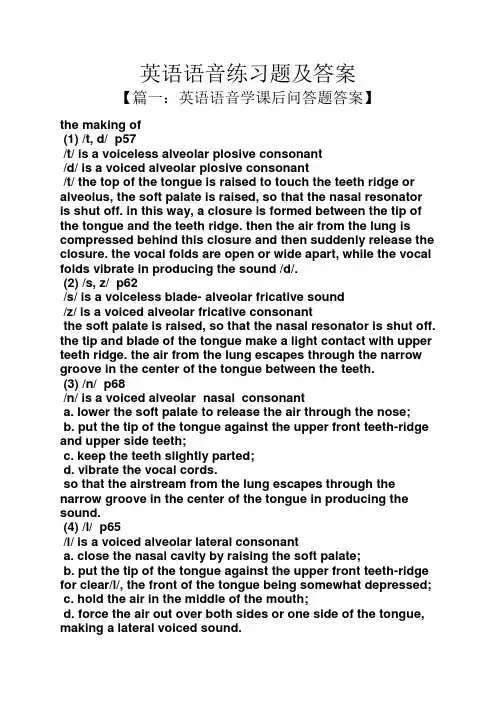
英语语音练习题及答案【篇一:英语语音学课后问答题答案】the making of(1) /t, d/ p57/t/ is a voiceless alveolar plosive consonant/d/ is a voiced alveolar plosive consonant/t/ the top of the tongue is raised to touch the teeth ridge or alveolus, the soft palate is raised, so that the nasal resonator is shut off. in this way, a closure is formed between the tip of the tongue and the teeth ridge. then the air from the lung is compressed behind this closure and then suddenly release the closure. the vocal folds are open or wide apart, while the vocal folds vibrate in producing the sound /d/.(2) /s, z/ p62/s/ is a voiceless blade- alveolar fricative sound/z/ is a voiced alveolar fricative consonantthe soft palate is raised, so that the nasal resonator is shut off. the tip and blade of the tongue make a light contact with upper teeth ridge. the air from the lung escapes through the narrow groove in the center of the tongue between the teeth.(3) /n/ p68/n/ is a voiced alveolar nasal consonanta. lower the soft palate to release the air through the nose;b. put the tip of the tongue against the upper front teeth-ridge and upper side teeth;c. keep the teeth slightly parted;d. vibrate the vocal cords.so that the airstream from the lung escapes through the narrow groove in the center of the tongue in producing the sound.(4) /l/ p65/l/ is a voiced alveolar lateral consonanta. close the nasal cavity by raising the soft palate;b. put the tip of the tongue against the upper front teeth-ridge for clear/l/, the front of the tongue being somewhat depressed;c. hold the air in the middle of the mouth;d. force the air out over both sides or one side of the tongue, making a lateral voiced sound.2. classify the vowels in different ways. p16-17the pure vowels can be classified according to different 4 principles.(2) according to the length of the vowels, they are divided into long vowels and short vowels. the pure vowels in transcription with two dots are long vowels. the diphthongs are also long. the rest are short ones.(3) according to the shape of the lips, the vowels can be divided into rounded vowels and uounded (spread) vowels. the rounded vowels are /?:/ /u:/ /?/ /?/ and the rest are uounded vowels.(4) according to the degree of tenseness of the muscles, the pure vowels are classified asthe eight diphthongs can be classified as closing diphthongs /e?/ /a?/ /??/ /??/ /a?/.and centring diphthongs /??/ /e?/ /??/.3. classify the consonants in different ways. p17-18there are 24 consonants in english. they are classified according to three different principles:1) the vibration of the vocal folds: those with the vibration of the vocal cords are called voiced consonants. those without the vibration of the vocal cords are called voiceless or breathed consonants.2) place of articulation: i.e., where the obstruction of the air passage is formed, the consonants can be distinguished as bilabial, labiodental, dental, alveolar, post-alveolar, palato-alveolar, palatal, velar, and glottal consonants.3) manner of articulation: they can be distinguished as plosives, fricatives, affricates, nasals, laterals, frictionless continuant and semi-vowels.4. how are /i:/ and /i/ produced? what’s the difference between them? p21-22/i:/: the front of the tongue is raised to a height slightly below and behind the front close position; the lips are spread; the tongue is tense; the side rims make a firm contact with the upper molars; it is generally long./i/: the rp vowel /i/ is pronounced with a part of the tongue nearer to the center than to front. it is raised just above the close-mid position; the lips are loosely spread; the tongue is lax; the side rims make a light contact with the upper molars; it is generally short.the difference is not merely the length of sound. there is also a difference in tongue position or quality. for /i:/ the part of the tongue that is highest is the centre of the “front” while for /i/ it is the hinder part of the “front”.5. what are the common features of the front vowels? p26(1) the front of the tongue is raised to various levels in the direction of the hard palate.(2) the tip of the tongue is usually kept down behind the lower teeth.(3) the lips are spread.6. how are the plosives produced? p56plosives are sounds resulting from a blocking or stopping effect on the airstream.6 plosives: /p/,/b/,/t/,/d/,/k/,/g//p/: a voiceless, bilabial plosive consonanta. raise the soft palate so that the nasal cavity is closed;b. breathe in the air and close the lips;c. hold the air behind the closure;d. part the lips open suddenly so that the air comes out of the mouth with a plosive sound;e. do not vibrate the vocal cords. /b/: a voiced bilabial consonantthe organic formation for /b/ is exactly the same as that for /p/ except that the air comes outof the mouth less forcefully and that the vocal cords vibrate./t/: a voiceless alveolar plosive consonanta. raise the soft palate so that the nasal cavity is closed;b. put the tip and blade of the tongue against the upper teeth ridge so that a closure isformed;c. hold the air behind the closure;d. release the closure and blade suddenly so that the air escapes with a plosive sound;e. do not vibrate the vocal folds. /d/: a voiced alveolar plosive consonantthe organic formation for /d/ is the same as that for /t/ except that the air is released less strongly and that the vocal folds vibrate./k/: a voiceless velar plosive consonant.a. raise the soft palate so that the nasal cavity is closed;b. lift the back of the tongue to touch the soft palate so that a closure is formed;c. stop the air stream behind the closure;d. break the closure and the plosive sound is heard;e. be careful not to vibrate the vocal folds./g/: a voiceless velar plosive consonantthe organic formation for /g/ is the same as that for /k/ except that the vocal cords vibrate when the air is released.7. how do you make the affricates /t?/and /d?/? p70/t?/: a voiceless palate-alveolar affricate consonanta. raise the soft palate to stop the air passage and put up the tip of the tongue to touch theback part of the teeth-ridge to form a retracted /t?/ closure;b. the main part of tongue is in position for /?/;c. release the closure slowly, and the air escapes all over the central part of the tongue withfriction;d. the lips are usually somewhat protruded;e. the vocal cords are not made to vibrate./d?/: a voiced palate-alveolar affricate consonantthe affricate /d?/ is formed like /t?/ except that the breath force is weaker and the vocal cords are made to vibrate.8. why are /w/ and /j/ called semi-vowels? p73the semi-vowels have both the features of vowels and consonants.9. please explain “open syllables” and “closed syllables”.p77open syllables are those without any consonant at the end. in british rp only a restricted set of vowels can occur.closed syllables are those that have one or more consonants at the end. all the vowels can appear in these circumstances.10. what is called incomplete plosion? p84when the release stage of a plosive sound is missing or delayed, it is known as incomplete plosion. it takes place in a word when a plosive is followed immediately by another plosive, or a fricative, or an affricate. it may also take place at the junction of words (unless they are separated by a pause).11. when do we have liaison? p86a. consonant (except r) + vowelthe final consonant of the preceding world is united tothe initial vowel of the next word in the same sense group.e.g. give it uphalf an hourb. –r or –re + vowelwhen a word ending with the letter”-r” or “-re” is followed by a wordbeginning with a vowel, the sound /r/ is usually inserted in the pronunciation.e.g. after all far and widec. vowel + vowelwhen a word ending in a vowel is followed by another word beginningwith a vowel, a short/j/ glide is inserted after /i:/, /i/, /ei/, /ai/ and /?i/, or a /w/ glide after /u:/,/u/,/?u/, and/au/e.g. at the endhurry up12. how do you explain assimilation? p95speech sounds seldom occur in isolation. in connected speech, under the influence of their neighbors, are replaced by other sounds. sometimes two neighboring sounds influence each other and are replaced by a new sound which is different from either of the two original sounds. this process is called assimilation.13. how many kinds of stress are there in a word? what are they? p107three principal kinds.(1) primary stress--heavily stressed, usually marked with a vertical stroke() on the upper left hand corner of a syllable carrying the stress, as in be’gin.(2) secondary stress--stressed but subordinate to the primary stress, usually marked with a vertical stroke (?) on the lower left hand corner of a syllable concerned, as in ?contribution.le stress or even stress. double stress can be marked by a high vertical stroke before each of the stressed syllable, as in /?f?f’ti:n/, /b ?:’l?n/, etc.14. how is sentence stress classified? for example. p115-119 three types: sense stress, logical stress, emotional stress.15. please define sense-groups. p140sense-groups are groups of words which are closely connected in meaning and grammar. each sense-group comprises a number of syllables. generally speaking, about six or seven syllables are considered appropriate.16. how many kinetic tones do you know? p153-154the tones which glide from one height to another are called kinetic tone. they are high fall, low fall; high rise, low rise; high fall-rise, and low fall-rise; rise-fall and rise-fall-rise.17. what is a tune? what are the features of the englishtune?p159,164the intonation of the whole tone-group is called a tune.a. normally a low prehead.b. normally a high head.c. in the body, the stressed syllables occupy mostly level pitches and they all fall downgradually in pitch. the unstressed syllables between the stresses ones have about the same height as the stressed syllable preceding them.d. the nucleus is usually at the end of the tune when something is uttered in isolation.e. the changes in the tail are determined by the nucleus. in a fall, the tail remains on a lowlevel pitch[ ]; in a rise or fall-rise, the tail rises gradually[ ]. 18. what’s the function of the falling-rising tune? p173it is used to show contrast, reservation, implication, disagreement, contradiction or warning, etc.1) declarative sentence: the falling-rising tune used in declarative sentences indicates incompleteness and implications, such as concession, gratitude, regret, apology, request, reproach and rebut, etc.2) interrogative sentences:a. special questions: the falling-rising tune used in the special question is stronger than the rising tune. it expresses surprise, interest, request, sympathy, disgust and disbelief, etc.b. general questions: the falling-rising tune used in the general question can express hesitation, request, agitation, exaggeration, etc. no answer is expected by the speaker. c. disjunctive question.3) imperative sentence: the falling-rising tune used in the imperative sentence expresses a warning or an urgent request.4) exclamatory sentence: the falling-rising tune is seldom used in exclamatory sentences. however, when used, it expresses enthusiasm, appreciation, sympathy, encouragement, regret and contempt, etc.【篇二:英语音标练习题—判断发音(含答案)[1]_2】>一、选出划线部分与其他三项发音不同的一项 ( c( a ( d ( b ( b ( a( d( b ( a ( c ( d ( c ( a ( b ( c( a ( d ( b ( a ( a ( b( c ( b ( c ( b ( d ( d ( c ( b( a ( b ( c ( c ( a( a ( b ( d ( d- 1 -- 2 -(((((((((((((((((((((((【篇三:英语语音练习题一】国际音标共48个音素,其中元音音素20个,辅音音素28个。
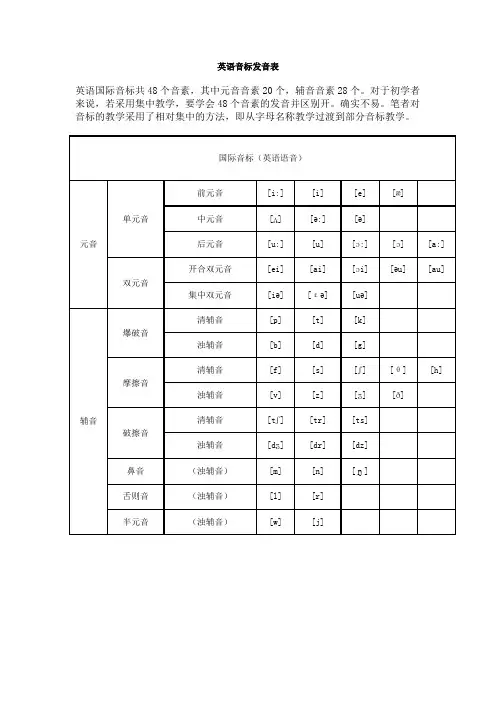
英语音标发音表英语国际音标共48个音素,其中元音音素20个,辅音音素28个。
对于初学者来说,若采用集中教学,要学会48个音素的发音并区别开。
确实不易。
笔者对音标的教学采用了相对集中的方法,即从字母名称教学过渡到部分音标教学。
语音知识:1) 字母:语言的书写形式。
元音字母只有a,e,i(y),o,u2) 音素:音的最小的单位。
英语中有48音素。
即20个元音音素和28个辅音音素.3) 元音:发音响亮,是乐音;口腔中气流不收阻碍;是构成音节的主要音。
英语中有20元音。
4) 辅音:发音不响亮,是噪音;口腔中气流受到阻碍;不是构成音节的主要音。
英语中有28辅音。
5) 音节:由元音和辅音构成的发音单位。
ap'ple,stu'dent,tea'cher,un'der'stand。
6) 开音节:a) 辅音+元音+辅音+e name bike home due;b) 辅音+元音he,go,hi。
7) 闭音节:a) 辅音+元音+辅音bad,bed,sit,hot,cup;b)元音+辅音it。
8) 重读音节:单词中发音特别响亮的音节。
/i:/ bee/bi:/ feet/fi:t/ keep/ki:p/ key/ki:/ team/ti:m/ meet/mi:t//i/ it /it/ big/big/ city/siti/ give/giv/ sick/sik//e/ get/get/ best/best/ text/tekst/ help/help//æ/ fat/fæt/ have/hæv/ cat/kæt/ back/bæk/ hat/hæt//a:/ laugh/la:f/ glass/gla:s/ half/ha:f/ farm/fa:m/ park/pa:k// ɔ:/ horse/hɔ: s/ saw/sɔ:/ corn/kɔ:n/ course/kɔ:s/ salt/sɔ:t// ɔ / dog/dɔg/ pot/pɔt/ cost/kɔst/ what/wɔt/ honest/′ɔnist//u:/ food/fu:d/ moon/mu:n/ rule/ru:l/ loose/lu:s/ noon/nu:n//u/ book/buk/ put/put/ good/gud/ would/wud/ could/kud// ʌ / must/mʌst/ does/dʌz/ money/′mʌni/ ugly/′ʌgli/ come/kʌm//ə:/ nurse/nə:s/ bird/bə:d/ burn/bə:n/ turn/tə:n/ girl/gə:l//ə / better/betə/ never/nevə/ worker/wə:kə/ welcome/welkəm//ei/ may/mei/ name/neim/ game/geim/ eight/eit/ age/eidʒ//əu/ no/nəu/ home/həum/ hope/həup/ wrote/rəut/ note/nəut/ pose/pəuz/ /ai/ eye/ai/ time/taim/ buy/bai/ right/rait/ bike/baik/ kite/kait//au/ now/nau/ out/aut/ how/hau/ about/ ə′baut/ south/sauθ/ house/haus/ /ɔi/ boy/bɔi/ toy/tɔi/ noise/nɔiz/ voice/vɔis/ point/pɔint/ coin/kɔin//iə/ ear/iə/ near/niə/ idea/ai′diə/ hear/hiə/ mere/miə/ spear/spiə//εə/ air/εə/ tear/tεə/ care/kεə/ dare/dεə/ fair/fεə/ there/ðεə//uə/ tour/tuə/ poor/puə/ sure/ʃuə/ moor/muə/(停泊) your/juə//p/ pea/pi:/ pie/pai/ top/tɔp/ cap/kæp/ people/pi:pl/ pride/praid//b/ bee/bi:/ by/bai/ buy/bai/ black/blæk/ bear/bεə//t/ let/let/ sat/sæt/ feet/fi:t/ team/ti:m/ tide/taid//d/ led/led/ sad/sæd/ feed/fi:d/ do/du:/ dear/diə//k/ lack/læk/ take/teik/ clock/klɔk/ class/kla:s/ weekend/′wi:kend//g/ big/big/ lag/læg/ glass/gla:s/ gum/gʌm/ good/gud/ guest/gest//f/ face/feis/ fast/fa:st/ leaf/li:f/ surf/sə:f/ favorite/′feivərit//v/ very/′veri/ five/faiv/ fever/′fi:və/ serve/sə:v/ never/′nevə//θ/ bath/ba:θ/(v洗澡) thick/θik/ mouth/mauθ/ breath/breθ/(n呼吸) thought/θɔ:t/ author/´ɔθə/ truth/tru:θ//ð/ the/ ðə/ they/ðei/ that/ðæt/ mother/′mʌðə/ thus/ ðʌs/ then/ðen//s/ face/feis/ mouse/maus/ cakes/keiks/ caps/kæps/ likes/laiks/ stops/stɔps//z/ close/kləuz/ keys/ki:z/ boys/bɔiz/ pens/penz/ halves/ha:vz//tʃ/ catch/kætʃ/ cheep/tʃi:p/ rich/ritʃ/ watch/wtʃ/ child/tʃaild/ question/kwestʃən/ teach/ti:tʃ/ challenge/tʃlindʒ//dʒ/ orange/′ɔridʒ/ large/la:dʒ/ juice/dʒu:s/ job/dʒɔb//tr/ tree/tri:/ try/trai/ true/tru:/ trouble/traubl/ track/træk//dr/ dry/drai/ dream/dri:m/ dress/dres/ drink/driŋk/ hundred/′hʌndrid//ʃ/ she/ʃi:/ sharp/ʃa:p/ fish/fiʃ/ shock/ʃɔk/ shoe/ʃu://ʒ/ pleasure/′pleʒə/ measure/′meʒə/ television/′teliviʒən//ts/ let′s/lets/ sports/spɔ:ts/ puts/puts/ writes/raits/ seats/si:ts//dz/ hands/hændz/ birds/bə:dz/ friends/freindz/ beds/bedz/ stands/stændz//h/ he/ hi:/ hard/ha:d/ him/him/ heard/hə:d/ half/ha:f//l/ like/laik/ late/leit/ learn/lə:n/ lead/li:d/ light/lait//m/ my/mai/ more/mɔ:/ seem/si:m/ meat/mi:t/ mind/maind/ men/men/ /n/ nice/nais/ wind/waind/ mind/maind/ rain/rein/ fine/fain//ŋ/ sing/siŋ/ wing/wiŋ/ ring/riŋ/ long/lɔŋ/ beautiful/bju:təfl//j/ you/ju:/ few/fju:/ yard/ja:d/ music/′mju:zik/ student/′stju:dnt/ excuse/ik′skju:z//w/ work/wə:k/ way/wei/ well/wel/ what/wɔt/ twelve/twelv/ twin/twin//r/ red/red/ road/rəud/ write/rait/ wrong/rɔŋ/ problem/′prɔbləm/音标综合练习1./i:/ /i/ /e/ /æ//bit/ /wi:k/ /di:l/ /riəl/ /kid/ /dig/ /kwik/ /tip/ /zip/ /rid/ /wil/ /fil/ bit week deal real kid dig quick tip zip rid will fill /pet/ /pæk/ /gæp/ /kæg/ /næg/ /ræm/ /bætl/ /sed/ /′hæpi/ /ten/ /red/pet pack gap cap nag ram battle said happy ten red/′setl/ /træʃ/ /di′pend/settle trash depend2./a:/ / ɔ:/ / ɔ / /u:/ /u//a:sk/ /ma:sk/ /pa:st/ /fra:ns/ /ɔd/ /lɔ:n/ /nɔ:t/ /pɔ:z/ /fɔks/ /sɔk/ ask mask past France odd lawn naught pause fox sock/fa:/ /la:dʒ / /ma:k/ /lɔ:d/ /tɔ:/ /stɔ:m/ /pɔt/ /krɔp/ /θɔt/ /prɔmis/ far large mark Lord torch storm pot crop thought promise/huk/ /lu:s/ /sut/ /tuk/ /mud/ /θru:/ /pul/ /wud/hook loose soot took mood through pull wood3./ʌ/ /ə/ /ə//bʌz/ /dʌl/ /′hʌri/ /gʌlf/ /′trʌbl/ /ə:n/ /sə:f/ /′tə:nə/ /′begə/ /tʌk/ buss dull hurry gulf trouble earn surf turner begger tuck/kə:b/ /ə:k/ /ə′merik / /′sɔkə/ /′kæmpə/ /sə′vei/ /pə′veid/ /pə′hæps/ curb irk America soccer camper survey pervade perhaps/bə:′lesk/ /′mə:də/burlesque murder3./ei/ /əu/ /ai/ /au/ /ɔi//keip/ /greit/ /mein/ /prəpəuz/ /′məuʃən/ /stəun/ /′əuvə/ /sait/ kape great main propose motion stone over sight/raim/ /daut/ /′taipist/ /aust/ /mɔist/ /′ɔistə/rhyme doubt typist oust moist oyster4./iə/ /ɛə/ /uə//viə/ /ə′fɛə/ /dɛə/ /skɛə/ /buən/ /guəd/ /′ruərəl/ /ə′piə/ /kəlʌmbiə/ veer affair dare scare bourn gourd rural appear Colombia/mətiəriəl/ /mistiəriəs/material mysterious5./θ/ /ð//mʌnθ/ /θi:f/ /ðæt/ /ðæn/ /feiθ/ /tə′geðə/ /θæŋk/ /ðəm′selvz/ month thief that than faith together thank themselves一. 找出画线部分读音不同的单词(每题2分,共20分)( ) 1. A. tea B. meat C. weather D. beach( ) 2. A. back B. fast C. have D. map( ) 3. A. warm B. garden C. market D. party( ) 4. A. school B. tooth C. choose D. good( ) 5. A. book B. moody C. look D. cook( ) 6. A. June B. ruler C. put D. menu( ) 7. A. push B. fun C. sun D. ugly( ) 8. A. tiger B. her C. officer D. over( ) 9. A. go B. no C. cold D. hot( ) 10.A. like B. lion C. pizza D. Friday()11.A.too B.classroom C.broom D.afternoon()12.A.houses B.spell C.student D.sister()13.A.colour B.American C.doctor D.licence()14.A.teacher B.seat C.sweater D.please()15.A.which B.who C.what D.where()16.A.little B.thing C.white D.with()17.A.yellow B.brown C.window D.know()18.A.worry B.sky C.only D.many()19.A.school B.chair C.China D.much()20.A.these B.they C.brother D.three( )21. A. brother B. come C. police D .mothers( )22. A .cinema B. climb C. sister D. film( )23. A. these B. bath C. think D .health( )24 . A. morning B. color C. work D. doctor( )25. A. basement B. favorite C. basket D. table( )26. A. island B. small C. ask D. helps( )27. A. mouth B. dangerous C. thousand D. about( )28. A. beach B. meal C. theatre D. leave( )29. A. how B. snow C. tomorrow D. own ( )30. A. large B. language C. giraffe D. great 二.根据音标写单词:[blu:] [da:ns] [mu:n] [fa:] [laik] [geit] [tju:b] [flai] [lend] [priti] [lesn ] [hæpi ][fæmili] [plei] [fɔks][tə′geðə] [meni] taigə三.在单词音标的下面写出单词:1、单元音:2、双元音:3、清、浊辅音:I, 复习26个字母:1,请按顺序默写出26个英文字母(含大小写)。
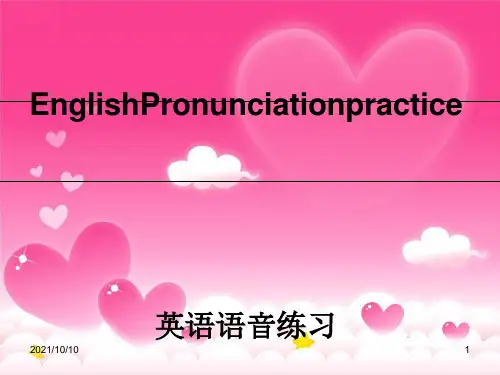
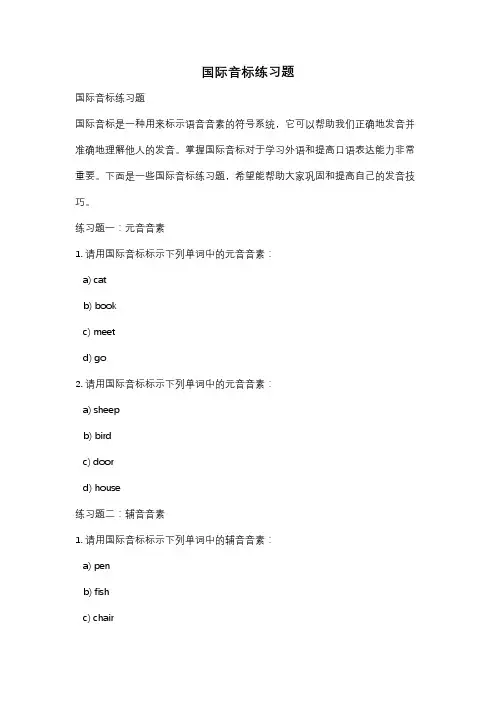
国际音标练习题国际音标练习题国际音标是一种用来标示语音音素的符号系统,它可以帮助我们正确地发音并准确地理解他人的发音。
掌握国际音标对于学习外语和提高口语表达能力非常重要。
下面是一些国际音标练习题,希望能帮助大家巩固和提高自己的发音技巧。
练习题一:元音音素1. 请用国际音标标示下列单词中的元音音素:a) catb) bookc) meetd) go2. 请用国际音标标示下列单词中的元音音素:a) sheepb) birdc) doord) house练习题二:辅音音素1. 请用国际音标标示下列单词中的辅音音素:a) penb) fishc) chaird) dog2. 请用国际音标标示下列单词中的辅音音素:a) mapb) vanc) thinkd) zoo练习题三:连读和弱读1. 请用国际音标标示下列句子中的连读和弱读:a) I want to go to the park.b) Can you help me with my homework?c) It's raining outside.2. 请用国际音标标示下列句子中的连读和弱读:a) What time is it?b) I don't know how to swim.c) She's going to the store.练习题四:重音1. 请用国际音标标示下列单词中的重音:a) bananab) computerc) photographd) beautiful2. 请用国际音标标示下列句子中的重音:a) I can't believe you said that.b) He's coming to the party tonight.c) She's a talented musician.练习题五:连读和弱读1. 请用国际音标标示下列单词中的连读和弱读:a) gonnab) wannac) kindad) shoulda2. 请用国际音标标示下列句子中的连读和弱读:a) I'm gonna go to the movies.b) I wanna eat pizza for dinner.c) It's kinda cold outside.d) He shoulda called me yesterday.以上是一些国际音标的练习题,希望能帮助大家提高自己的发音技巧。
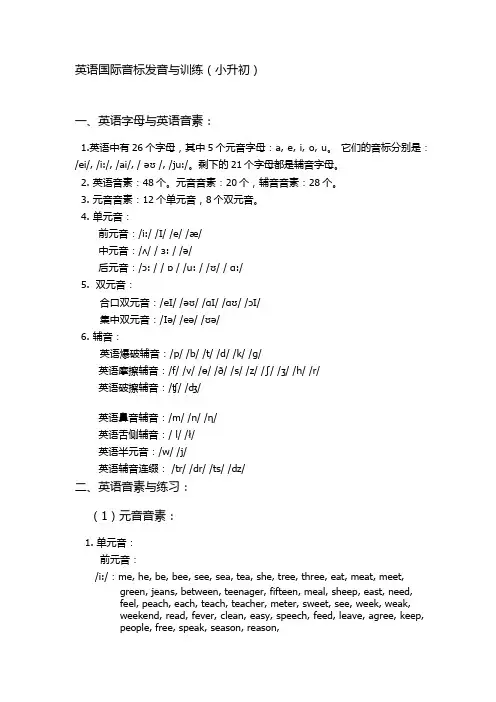
英语国际音标发音与训练(小升初)一、英语字母与英语音素:1.英语中有26个字母,其中5个元音字母:a, e, i, o, u。
它们的音标分别是:/ei/, /i:/, /ai/, / əʊ /, /ju:/。
剩下的21个字母都是辅音字母。
2. 英语音素:48个。
元音音素:20个,辅音音素:28个。
3. 元音音素:12个单元音,8个双元音。
4. 单元音:前元音:/i:/ /I/ /e/ /æ/中元音:/ʌ/ / ɜ: / /ə/后元音:/ↄ: / / ɒ / /u: / /ʊ/ / ɑ:/5. 双元音:合口双元音:/eI/ /əʊ/ /ɑI/ /ɑʊ/ /ↄI/集中双元音:/Iə/ /eə/ /ʊə/6. 辅音:英语爆破辅音:/p/ /b/ /t/ /d/ /k/ /g/英语摩擦辅音:/f/ /v/ /ө/ /ð/ /s/ /z/ /ʃ/ /ӡ/ /h/ /r/英语破擦辅音:/ʧ/ /ʤ/英语鼻音辅音:/m/ /n/ /ƞ/英语舌侧辅音:/ l/ /ł/英语半元音:/w/ /j/英语辅音连缀: /tr/ /dr/ /ts/ /dz/二、英语音素与练习:(1)元音音素:1. 单元音:前元音:/i:/:me, he, be, bee, see, sea, tea, she, tree, three, eat, meat, meet, green, jeans, between, teenager, fifteen, meal, sheep, east, need,feel, peach, each, teach, teacher, meter, sweet, see, week, weak,weekend, read, fever, clean, easy, speech, feed, leave, agree, keep,people, free, speak, season, reason,/I/ : in, this, will, his, six, miss, pink, sing, ill, kill, still, ticket, sit, it, bit, pick, sick, did, chick, lip, fish, milk, swim, ship, quick, lip, big, fill,pig, sister, dinner, wind, window, skipping, clinic, thin, rich, busy,wish, dish, finish, little, sing, spring, city, delicious/e/ : get, let, pet, desk, yes, chess, next, text, best, met, pen, pencil, bed, west, guest, tennis, egg, red, net, rest, set, test, wet, lend, mend,tell, well, fell, letter, sweater, head, bench, bread, many, ten, seven, end, medicine, help, check, yes, then, menu, never, ever, lesson,very, says, said,/æ/:fat, map, and, land, man, plan, bag, cat, apple, fan, Japan, dad, sad, sand, lad, stamp, black, hat, cap, ambulance, angry, have,catch, carry, stand, travel, hand, rabbit, animal, lamp, cabbage,family, dragon, Africa, bank, Saturday, can, candy, camera, act,happy, candle, than, that, thank, glad, matter, bad, happen,handsome, math, taxi,中元音:/ʌ/ :but, come, cut, must, bus, us, up, color, mother, such, uncle, duck, luck, lucky, fun, funny, sun, sunny, love, worry, son, brother,other, another, study, lunch, Sunday, under, umbrella, number,nothing, wonderful, run, running, young, cover, above, money,much, cup, cousin, monkey, Monday, summer, brush, trouble,something, some, just, supper, country,/ɜ:/ :girl, shirt, bird, skirt, nurse, work, worker, first, thirteen, third, thirty, dirty, thirsty, worth, birth, birthday, circle, world, her, early,turn, person, Thursday, worm, prefer, certain, temperature, heard, learn, earth,/ə/: teacher, mother, father, sister, brother, farmer, driver, singer, dancer, worker, answer, under, visitor, waiter, writer, bigger,winter, soldier, meter, theater, manager, cleaner, ruler, eraser,woman, picture, future, camera, tiger, actor, China, number, after, 后元音:/ↄ: / :four, for, short, door, floor, more, before, wall, call, all, tall, ball, draw, saw, horse, or, daughter, report, reporter, boring, warm,talk, your, north, forty, sport, autumn, fall, important, bought,thought, ought, because, corn, corner, born, store, score,/ ɒ / :box, dog, doctor, doll, often, lot, top, boss, chopstick, shop, job, sock, office, coffee, got, golf, long, hospital, orange, lost, bottle,crocodile, tomorrow, borrow, cost, hot, on, wash, watch, song,follow, what, stop, fox, frog, wallet, not, sorry,/u: / :too, zoo, room, pool, food, goose, tooth, school, stool, soon, moon, kangaroo, cool, noon, tool, fool, broom, cartoon, choose,shoot, afternoon, juice, blue, noodles, true, truth, fruit, shoes,through, lose, group, do, ruler, two,/ʊ/ :good, cook, took, book, foot, stood, wood, look, wool, classroom, bathroom, bedroom, mushroom, boyhood, woman, put, full,notebook, could, would, should, wolf, sugar, push,oo字母组合发短音的常见8个单词:A good cook took a book, his foot stood by the wood and look ed.好厨师拿书,脚站树林看。
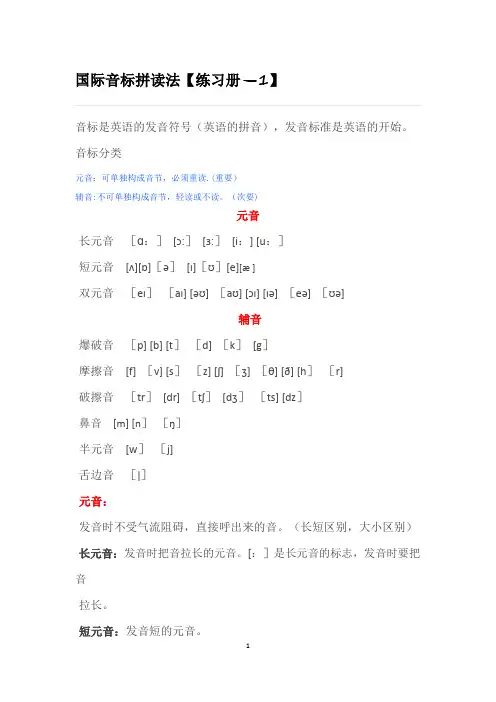
国际音标拼读法【练习册—1】音标是英语的发音符号(英语的拼音),发音标准是英语的开始。
音标分类元音:可单独构成音节,必须重读.(重要)辅音:不可单独构成音节,轻读或不读。
(次要)元音长元音[ɑ:][ɔ:][ɜ:][i:] [u:]短元音[ʌ][ɒ][ə][ɪ][ʊ][e][æ ]双元音[eɪ][aɪ] [əʊ] [aʊ] [ɔɪ] [ɪə] [eə] [ʊə]辅音爆破音[p] [b] [t][d] [k][g]摩擦音[f] [v] [s][z] [ʃ] [ʒ] [θ] [ð] [h][r]破擦音[tr][dr] [tʃ][dʒ][ts] [dz]鼻音[m] [n][ŋ]半元音[w][j]舌边音[ǀ]元音:发音时不受气流阻碍,直接呼出来的音。
(长短区别,大小区别)长元音:发音时把音拉长的元音。
[:]是长元音的标志,发音时要把音拉长。
短元音:发音短的元音。
双元音:发音由2个单元音合成的元音。
长元音(发音2秒)[ɑ:]:发“啊”音,大嘴感叹音。
[ɔ:]:长“噢"音,噢噢叫的音.[ɜ:]:长“鹅”音,卷舌音。
[i:]:长“衣"音,嘴角要向两边裂开,像微笑。
[u:]:长“呜"音,火车鸣笛。
短元音(发音短而有力,干净利落)[ʌ]:短“啊”音.发音不完全与“啊”相同。
口小一些,松一些。
[ɒ]:短“噢”音。
发音不完全与“噢”相同。
口大一些。
[ə]:短“鹅”。
可卷舌,可不卷舌。
[ɪ]:短“衣”,快速,发音不完全和“衣"相同。
口松一些。
[ʊ]:短“呜”,发音不完全和“呜"相同,口松一些.[e]:短“唉”,“唉”的小嘴,小嘴鸡蛋音,一横指。
例:egg,bed [æ ]:“唉”的大嘴,嘴张到最大,后口腔发音,大嘴呕吐音,大嘴苹果音。
例:apple,bad双元音(饱满,夸张)整体发音[eɪ]:发英语的“A”音。
例:day[aɪ]:发英语的“I”音.大嘴,夸张,得足够饱满。
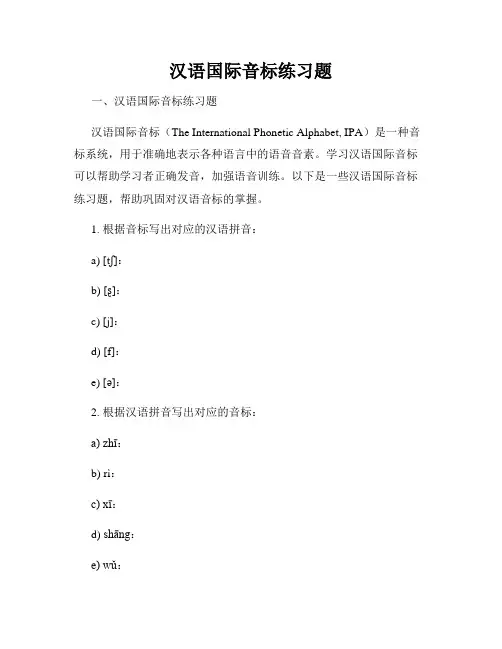
汉语国际音标练习题一、汉语国际音标练习题汉语国际音标(The International Phonetic Alphabet, IPA)是一种音标系统,用于准确地表示各种语言中的语音音素。
学习汉语国际音标可以帮助学习者正确发音,加强语音训练。
以下是一些汉语国际音标练习题,帮助巩固对汉语音标的掌握。
1. 根据音标写出对应的汉语拼音:a) [tʃ]:b) [ʂ]:c) [j]:d) [f]:e) [ə]:2. 根据汉语拼音写出对应的音标:a) zhī:b) rì:c) xī:d) shāng:e) wǔ:3. 汉语国际音标里有几个鼻音?请写出它们的音标和拼音。
4. 根据音标写出对应的单词:a) [kɑ]:b) [læŋ]:c) [dai]:d) [mɪ]:e) [nai]:5. 根据单词写出对应的音标:a) pinyin:b) zhongwen:c) meili:d) chifan:e) xuexi:6. 写出下列字母组合对应的音标:a) ai:b) ou:c) ei:d) ie:e) ua:7. 根据音标写出合适的词语:a) [həʊ]:b) [ti:]:c) [si:]:d) [mæn]:e) [tu:]:8. 写出下列词语对应的音标:a) 苹果:b) 马蜂:c) 音乐:d) 书房:e) 高兴:二、答案1. 根据音标写出对应的汉语拼音:a) [tʃ]:chb) [ʂ]:shc) [j]:yd) [f]:fe) [ə]:e2. 根据汉语拼音写出对应的音标:a) zhī:[ʈʂ]b) rì:[ɻ]c) xī:[ɕ]d) shāng:[ʂ]e) wǔ:[u]3. 汉语国际音标里有几个鼻音?请写出它们的音标和拼音。
汉语国际音标里有3个鼻音:- [m]:拼音m,如“妈妈”;- [n]:拼音n,如“鸟”;- [ŋ]:拼音ng,如“青”。
4. 根据音标写出对应的单词:a) [kɑ]:卡b) [læŋ]:浪c) [dai]:代d) [mɪ]:米e) [nai]:乃5. 根据单词写出对应的音标:a) pinyin:[pʰin.jin]b) zhongwen:[ʈʂʊŋ.wən]c) meili:[mẽi.li]d) chifan:[ʈʂʰɨ.fan]e) xuexi:[ɕɥe.ɕi]6. 写出下列字母组合对应的音标:a) ai:[ai]b) ou:[ou]c) ei:[ei]d) ie:[jɛ]e) ua:[wa]7. 根据音标写出合适的词语:a) [həʊ]:好b) [ti:]:题c) [si:]:四d) [mæn]:满e) [tu:]:图8. 写出下列词语对应的音标:a) 苹果:[pʰiŋ.guo]b) 马蜂:[ma.fɤŋ]c) 音乐:[in.jy]d) 书房:[ʂu.fɑŋ]e) 高兴:[kɑu.xiŋ]以上是汉语国际音标练习题及答案。
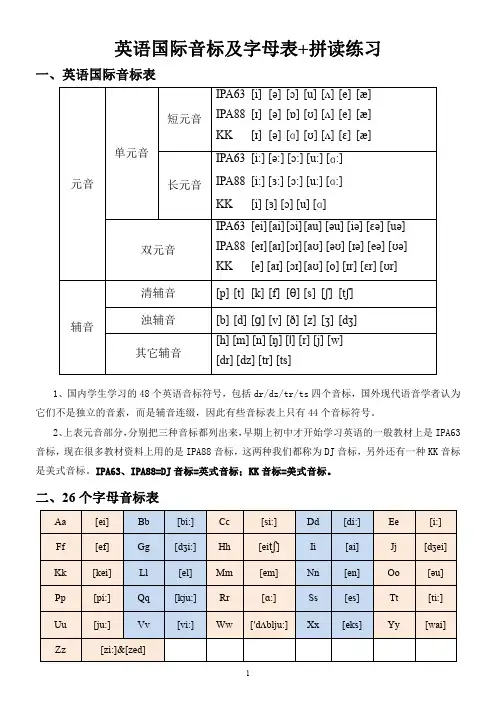
英语国际音标及字母表+拼读练习一、英语国际音标表元音单元音短元音IPA63[i][ə][ɔ][u][ʌ][e][æ]IPA88[ɪ][ə][ɒ][ʊ][ʌ][e][æ]KK[ɪ][ə][ɑ][ʊ][ʌ][ɛ][æ]长元音IPA63[i:][ə:][ɔ:][u:][ɑ:]IPA88[i:][ɜ:][ɔ:][u:][ɑ:]KK[i][ɜ][ɔ][u][ɑ]双元音IPA63[ei][ai][ɔi][au][əu][iə][ɛə][uə]IPA88[eɪ][aɪ][ɔɪ][aʊ][əʊ][ɪə][eə][ʊə]KK[e][aɪ][ɔɪ][aʊ][o][ɪr][ɛr][ʊr]辅音清辅音[p][t][k][f][θ][s][ʃ][tʃ]浊辅音[b][d][g][v][ð][z][ʒ][dʒ]其它辅音[h][m][n][ŋ][l][r][j][w][dr][dz][tr][ts]1、国内学生学习的48个英语音标符号,包括dr/dz/tr/ts四个音标,国外现代语音学者认为它们不是独立的音素,而是辅音连缀,因此有些音标表上只有44个音标符号。
2、上表元音部分,分别把三种音标都列出来,早期上初中才开始学习英语的一般教材上是IPA63音标,现在很多教材资料上用的是IPA88音标,这两种我们都称为DJ音标,另外还有一种KK音标是美式音标。
IPA63、IPA88=DJ音标=英式音标;KK音标=美式音标。
二、26个字母音标表三、通过简单单词,学习音标拼读元音[i:]eat[i:t]吃[i]sit[sit]坐[ə:]bird[bə:d]鸟[ə]sofa['səufə]沙发[ɔ:]horse[hɔ:s]马[ɔ]box[bɔks]盒子[u:]food[fu:d]食物[u]book[buk]书[ɑ:]park[pɑ:k]公园[ʌ]bus[bʌs]公汽[e]bed[bed]床[ei]lake[leik]湖[æ]bad[bæd]坏的[ai]kite[kait]风筝[ɔi]boy[bɔi]男孩[au]cow[kau]奶牛[əu]goat[gəut]山羊[iə]hear[hiə]听见[ɛə]hair[hɛə]头发[uə]tour[tuə]旅行辅音[p]put[put]放置[t]take[teik]递走[k]key[ki:]钥匙[f]food[fu:d]食物[θ]thank[θæŋk]感谢[s]see[si:]看[ʃ]ship[ʃip]船[tʃ]teacher['ti:tʃə]老师[b]boy[bɔi]男孩[d]day[dei]天[g]go[gəu]走[v]very['veri]非常[ð]that[ðæt]那个[z]busy['bizi]忙[ʒ]vision[ˈvɪʒən]视力[dʒ]job[dʒɔb]工作[h]he[hi:]他[m:]me[mi:]我[n]name[neim]名字[ŋ]think[θiŋk]想[l]long[lɔŋ]长的[r]read[ri:d]读[j]you[ju:]你[w]work[wə:k]工作[dr]drink[driŋk]喝[dz]bed[bedz]床[tr]tree[tri:]树[ts]lots[lɔts]许多四、特殊情况(音标不变,发音变)/p/在s后浊化发/b/音,如spring英音:[spriŋ],speak英音:[spi:k];/t/在s后浊化发/d/音,如stay英音:[stei];/k/在s后浊化发/g/音,school英音:[sku:l]。
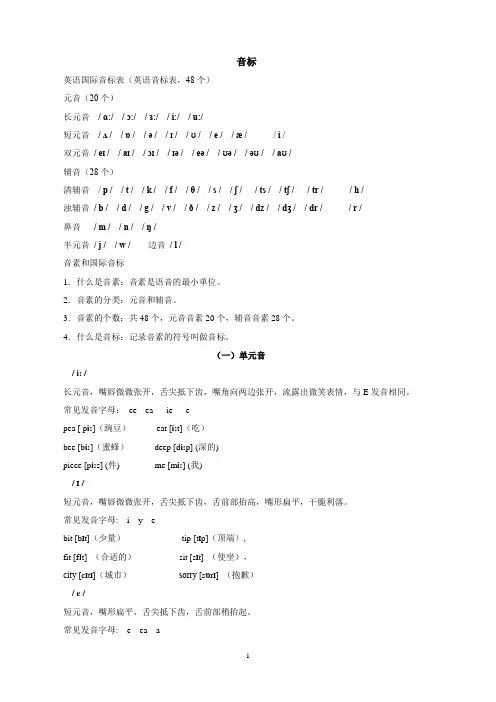
音标英语国际音标表(英语音标表,48个)元音(20个)长元音/ ɑ:/ / ɔ:/ / ɜ:/ / i:/ / u:/短元音/ ʌ / / ɒ / / ə / / ɪ / / ʊ / / e / / æ / / i /双元音/ eɪ / / aɪ / / ɔɪ / / ɪə / / eə / / ʊə / / əʊ / / aʊ /辅音(28个)清辅音/ p / / t / / k / / f / / θ / / s / / ʃ / / ts / / tʃ / / tr / / h /浊辅音/ b / / d / / g / / v / / ð / / z / / ʒ / / dz / / dʒ / / dr / / r /鼻音/ m / / n / / ŋ /半元音/ j / / w / 边音/ l /音素和国际音标1.什么是音素:音素是语音的最小单位。
2.音素的分类:元音和辅音。
3.音素的个数:共48个,元音音素20个,辅音音素28个。
4.什么是音标:记录音素的符号叫做音标。
(一)单元音/ i: /长元音,嘴唇微微张开,舌尖抵下齿,嘴角向两边张开,流露出微笑表情,与E发音相同。
常见发音字母:ee ea ie epea [ p i:](豌豆)eat [i:t](吃)bee [b i:](蜜蜂)deep [d i:p] (深的)piece [p i:s] (件) me [m i:] (我)/ ɪ /短元音,嘴唇微微张开,舌尖抵下齿,舌前部抬高,嘴形扁平,干脆利落。
常见发音字母: i y ebit [bɪt](少量)tip [tɪp](顶端),fit [f I t] (合适的)sit [sɪt] (使坐),city [cɪtɪ](城市)sorry [sɒrɪ] (抱歉)/ e /短元音,嘴形扁平,舌尖抵下齿,舌前部稍抬起。
常见发音字母: e ea aegg [eg] (鸡蛋),get [get] (到达),head [hed] (头), bread [bred] (面包),very [‘veri] (很,完全) tell [tel] (告诉)/ æ /上下齿间可容两指宽度短元音,嘴张大,舌尖抵下齿,嘴角尽量拉向两边,成扁平形。


国际音标第一节音标与相应字母元音辅音1.单元音[i:] -- he ,we, /sheep, week/ please,[p ]-- up, please,plane. map, ship [i ]——it, is, big, build, happy, city [e] ---egg, bed, let, next, west, lend [?]--- apple, bag, black, hand,[:]——ask, last, fast, after, farm, []--- us, bus, brother, son, much, [ 卜--or, order, horse, more, four, [ ]--- box, lot, hot, fox, stop, [u:]--- too, moon, soon, noon, [u ]--- look, book, good, food, [?:]-- girl, bird, thirteen, earth, [? ] --- about, along, teacher, [f ] --- if, floor, food, afternoon, [v ] ---v,vest, five, live.[k ] -- look, book, black, kate [g ] —good, get, gate, bag, leg, [s ] -- sit, student, class, [z ] -- zoo, is, has,[m ] -- me, may, arm, am. [n ] --not, nine, an, name[/ ] --ship, she, sheep. Englsh []--usual, pleasure.[ei ]--name, face, wake, great [ai]---like,bike,mine,my [?u ]---go, so, note, bellow [au ]--- out, about, now, how. [i? ]-- ear, hear, here, idea [e? ]-- air, hair, chair, there, [u?]--sure, poor[0 卜three, thin, month [ ]--they, then, father, other [l ] --like, long, black/ pencl, little []--long, song, morning[r ] -- red, room, ring, wrong [h ] -- home,hope, hello [w ] --we, wall, worker [j ] --you, yes,yet young双辅音[t / ]-- ea ch, bea ch, ch ild, [tr]-- [d ] --- age, orange, bridge [ts ] -- studerts, wants[dz ] -- hands blackbaords 第二节容易混淆的音1.单辅音[b ]-- book, blue, black, lab. [t ]--- it, at, take, talk [d ]---desk,date, add,tr ee, tr y, tr ue[dr ]---- drive, dry, hundred[ei] [mei] leik] Pei] [peil] [g][w] wij -- wout] weik] west] wis] [v] yiT" vout]veit] vest]vis] [j] [d ][jes] [d es] [j ] [d d[j?uk [d?jk] [j:k] [d:d ] [?] [] [n] [m?g] [g?p] [l?mp ][mg] [g p] [l mp][n?p] [nein ] :nait] [ni:d] [ai] [mai] laik] Pai] [pail][m][n]DI nrm[l?p] leim] lait] [li:d] [sp:t ] [n:6] h:s] [w:l] [spu:t| [nu:dl] [hu:z] [wu:l] [s][6][z][]mo:mi:t] em] pleim] [J] [J i :] [J ?] [/u?] ['pl J ? [l][1st] ['lgist] [leik] ■ltsf] [laud] 第三柳读技能训练 1.朗读下列音标意其区别 2朗读下列 1)注意不 p[ij male - meal[mi:l] Lake leak [li 漏] Dane [bi:t] [ti:n : li:d] [pi:k] deanEn^J] [i] [bid] tin] lid] [pik] [klik] [dip] pale peel [p 削皮 2)注意不要将读网i:]: pick [p 检]拾 lip [lip]嘴 唇 dip [dip click [k 声neik] no:]:ni :d] :en]plein []MJ :'P Ue ? [l]]]^1 m p p u •??-H ? ?[切 iuy t /:] t J au] t J ai] [n][pens[][nin ]:midl] bikl] [pi:pl] [fainl] [win] [sin] [min] [sn 需nms:[tr] it?r [tri;] :trau]:trai][wi ] [si ] [mi ] [s ]T T zl Mm z] •zl:0zu ze wi [d ] ^]E Jm ] -H 3 u e [dr]d aiv] [draiv] ;d 勿]1 [dfiUv] 'hAndr?d [d ?ik]]brid 词和音标 [e] [?] [ei] [i:] [bet] [b?t] [meil] [mi:l] ten] [t?n] [leik] [li:k] [ted] [l?d] [dein [di:n] [pek] [p?k] [peil [pi:l] [web] [w?b] [weik ] [wi:k ] 教务长丹麦人 [peil]苍白[meil]男性的 餐顿饭 [leik] peak [p®k 高i^] clique [k3) 注意不要将[i]误读成败[e]: tin[tin]铁罐ten [ten] 十lit [lit]点火(过去式)let [let] 让did [did]做(过去式) dead [ded] 死pin [pin]别针pen [pen] 钢笔4) 注意不要将错就错[e]读成[?]:men [men]男人(复数)man [m?n] 男人(单数)bed [bed]床bad [b?d] 坏的lend [lend]借岀land [l?nd] 土地pen [pen]钢笔pan [p?n] 平底锅5) 注意不要将[?]和[ai ]man [ m? n ]男人mine [ main ] 我的dad [ d? d ]爸爸died [ daid ]死(过去式)pal [p?l ]好友pile [ pail ]堆band [ b? nd ] 乐队bind [ baind ] 扎,捆6) 注意不要将[n]与[l]混淆: nap[ n?p]午睡lap [l?p] 漆name [neim] 姓名lame [leim]瘸night [nait] 晚上light [ lait]轻的need [ni:d] 需要lead [li:d] 领导3. 朗读下列词和音标[u:] [u] [] [] [a:] [ ][fu:d] [fut] [f :k] [f g] [fa:m [f n][pu:l] [pul] [p :l] [p t] [pa:t] [p k][bu:t] [buk] [b :n] [b b] [ba:n] [b n][ku:l] [kud] [k :n] [k t] [ka:t] [k t][mu:n] [mun] [m :] [n t] [ka:sl] [k t]4.朗读下列词和音标1)注意不要将[au ]误读成[?u ]:town [taun] 城,镇crowd [taun] 人群down [daun] 卜面brown [braun] 棕色clown [klaun] 小丑owl [aul] 猫头鹰noun [naun] 名词foul [faul] 污浊round [round] 圆ground [graund] 咆哮2)不要将[?u ]读成[ u ]bone [ boun ] 骨头hole [houl 洞blown [bloun 吹(过去式)bowl [boul ] 碗road [roud 路cold [kould ] 冷rope [ roup ] 绳fold [fould ] 折叠3)不要将[ ]读成[:]pot [p t ] 锅子port [p :t]海cot [k t ] 儿童卧床court [k :t ]法庭lot [l t ] 命运lord [l :d ]主人4)不要将[ r ] 读成败[l ]read [ri:d ]读lead [ li: d ] 领导right [ rait ]正确,右边 rock [ ro k ]石头 crowd [ kraud ] 人群 pray [prei]祈祷5.朗读下列音标,注意在 [s]后面的爆破清音[k] [p] [t]可以失去送气。
英语国际音标练习题一、元音部分:1、下面哪个音与/m/相似?A. /p/B. /v/C. /u/D. /n/2、下列哪个音与/ɪ/相似?A. /e/B. /i/C. /o/D. /u/3、下列哪个音与/ɑː/相似?A. /e/B. /i/C. /ɔ/D. /u/4、下列哪个音与/ʊ/相似?A. /e/B. /i/C. /ɔ/D. /u/5、下列哪个音与/əʊ/相似?A. /e/B. /i/C. /ɔ/D. /u/二、辅音部分:1、下列哪个音与/b/相似?A. /d/B. /f/C. /g/D. /t/2、下列哪个音与/dʒ/相似?A. /b/B. /g/C. /d/D. /f/3、下列哪个音与/tr/相似?A. /dʒ/B. /b/C. /g/D. /t∫/4、下列哪个音与/∫/相似?A. /p/B. /b/C. /m/D. /n/5、下列哪个音与/θ/相似?A. /s/B. /z/C. /∫/D. /b/英语国际音标英语音标课件单元音在国际音标中,单元音是英语发音的基础,它们是由一个元音音素构成的音节。
单元音包括以下12个音标:i/、/ɪ/、/e/、/ə/、/æ/、/ɑ:/、/ɔ:/、/ɒ:/、/ə:/、/ɜ:/、/i:/、/u:/每个单元音都有自己的发音特点,下面我们将逐个介绍这些音标及其发音特点。
1、/i:/:嘴微张,唇部扁平,舌身平放,舌尖抵住下齿。
2、/ɪ/:嘴微张,唇部扁平,舌身平放,舌尖抵住下齿,舌位略高于/i:/。
3、/e/:嘴半开,唇部稍收,舌尖抵住下齿,舌位稍低于/ɪ/。
4、/ə/:嘴半开,唇部稍收,舌身平放,舌位略高于/e/。
5、/æ/:嘴张大,唇部收拢,舌身平放,舌位略高于/ə/。
6、/ɑ:/:嘴张大,唇部收拢,舌身平放,舌位略低于/e/。
7、/ɔ:/:嘴张大,唇部稍收,舌身平放,舌位略高于/ɑ:/。
8、/ɒ:/:嘴张大,唇部稍收,舌身平放,舌位略低于/ɔ:/。
48个英语国际音标元音辅音及发音规则应用方法练习题音素:指语音的最小单位(指发音)音标:用来记录音素的符号(写在/ / 之间)音节: 由元音和辅音构成的发音单位.第I部分:元音<20个>发音特点:发音时声带振动,气流在通路上不受发音器官阻挡。
单元音:(12个)/ i:/ / ɪ / / e / / æ // ɜ:/ / ə / /?:/ / ʌ //ɔ:/ / ɒ / / u:/ / ʊ /双元音:(8个)/eɪ/ /aɪ/ /ɔɪ/ /əʊ/ /aʊ/ /ɪə/ /eə/ /ʊə/第II部分:辅音<28个>发音特点:发音时气流在通路上受到发音器官的阻挡,同时声带不振动是清辅音,声带振动是浊辅音。
清辅音:(11个)/ p / / t / / k / / f / / θ / / s / / ʃ / / tʃ / / tr / / ts / / h /浊辅音:(17个)/ b / / d / / g / / v / / ð / / z / / ʒ / /dʒ/ /dr/ /dz/ / r / / m / / n / / ŋ / / ǀ / / w/ / j /说明:1、几组常用音节:①/ ʌn / under ②/ ən / England ③/ æn / man④/ vən / seven ⑤/ aʊn / down ⑥/ ju: / you ⑦/ kw/quiet2、[ l ] 有两种发音:在元音前读清晰[ l ],在辅音前或词尾读含糊[ l ]eg: lake[leIk],little[li:tl ]3、清音浊化:/sp/→/sb/ spring, /st/→/sd/ stay, /sk/→/sg/ skirt, /str/→/sdr/ street.巩固部分:1、国际音标有多少个?其中元音多少个?辅音多少个?2、元音音素分哪两部分?各多少个?辅音分哪两部分?各多少个?3、标出以下音标中的元音音素:6个/ ɒ / 、/ ɜ:/ 、/ k / 、/ e / 、/dʒ/ 、/ɪə/ 、/ ?:/ 、/eə/ 、/ f / 、/ tʃ /音标的使用学习了元音和辅音之后,这节课我们要进一步学习一下他们的使用技巧:A . 用音标读单词的方法:先找单词音标中的元音音素,之后与其前辅音拼读发音。
国际音标表音标口诀:十对元音向外爬,辅音还有二十八。
元音分成双和单,前四后五中元三。
集双有三合双五,十一成双清浊辅。
爆三摩五破擦三,鼻音有三两半元。
还有一个就全了,声门舌侧卷舌/ l /。
48个音标发音要领讲义元音(20个,分为单元音和双元音)单元音:/ i: / / i / / e / / æ / / ə: / / ə/ / ʌ/ / a: / / ɔ: / / ɔ/ / u: / / u // i: / 长元音嘴唇微微张开,嘴巴成扁平状,舌尖抵下齿,口腔肌肉紧张,声音尖锐有力,面部表情呈微笑状。
e.g. eat / i:t / 吃bee / bi: / 蜜蜂see /si:/ 看见meet / mi:t / 遇见/ i / 短元音嘴唇微微张开,舌尖抵下齿,口形偏平,舌前部稍放低,发音短处有力,开口度比[i:] 大。
e.g. big / big / 大的is / iz / 是/ e /发音时舌尖抵下齿,舌前部稍抬起,嘴形扁平,上下齿之间距离为小指的宽度,口型自然放松,双唇稍扁。
(这个音容易忘记,忘记时想想字母F, L ,M ,N )Bed / bed / 床get / get / 到达desk / desk / 桌子/ æ /梅花音,舌尖抵下齿,嘴要故意张很大,上下齿之间可容纳食指和中指的宽度,双唇向两旁平伸,成扁平型。
apple/ ’æpl /苹果bad / bæd / 坏的sad / sæd / 伤心的hand / hænd / 手注意:开口度[]﹥[e] ﹥[i] ﹥[i:]/ ʒ: /嘴唇微张,放松,嘴形扁平,上下齿分开,舌头平放,中部微微抬高。
注意长度莫太短。
(忘记了怎么发,可借助“饿”)bird / bʒ:d /鸟sir / sʒ: /先生girl / gʒ:l / 女孩/ ə/发音时舌中部稍抬起,双唇扁平,口腔自然放松,发音干脆利索。
国际音标习题1.把下列音标分类。
[ ʊ ] [ l ] [Λ] [ j ] [ ] [ eә ] [ tr ] [ h ] [ iә ] [ d ] [ t ] [ ɒ ] [ ts ] [ ʊә ] [ p ] [ ð ] [ n ] [ ∫ ] [ æ ] [ k ] [ ɔi ] [ r ] [ әʊ ] [ dr ] 元音:辅音:2.根据音标,选择正确的单词。
white desk elephant lamp mouse/ wait // ΄elifәnt // maus // desk // læmp /3. 从B栏找出与A栏对应的单词或音标并连线。
(1) A B[θiŋ ] goat[dɔg ] pear[gәut ] thing[ feis ] dog[ peә ] face(2) A B[rәuz] theater['θiәtә] rose[skweә] tour[tuә] square[pleisiz] places(3) A Bsocks ['gigl]giggle [gәust]ghost [sɔks]face [t∫i:z]cheese [feis] (4) A B[kәuts]trousers[si:dz] coats[træ∫] seeds['draivә] trash[trauzәz] driver(5) A Bparrot [′pærәt]heart [lɔk]lock [ha:t]dollar [klaim]climb [′d ɔlә]4 . 找出画线部分读音不同的单词。
little thing white with 5 . 选出划线部分的发音。
[ u:] [ u ] [ ɔ ]meat thirsty driver animal hot classroom blue7 . 找出发音不同的单词:( ) 1. A. he B. feet C. bread D. green( ) 2. A. pig B. is C. dog D. ship( ) 3. A. thirty B. bird C. her D. food( ) 4. A. she B. big C. in D. money( ) 5. A. sweets B.fish C. teacher D. we( ) 6. A. cake B. egg C. rain D. May( ) 7. A. kite B. cry C. room D. fly( ) 8. A. boy B. joy C. cat D. noise( ) 9. A. blouse B. sun C. cow D.house( ) 10. A. tower B. flower C. mouth D.arm国际音标练习1、 把下列音标分类。
48个英语国际音标元音辅音及发音规则应用方法练习题.音素:指语音的最小单位(指发音)音标:用来记录音素的符号(写在/ / 之间)音节: 由元音和辅音构成的发音单位.第I部分:元音<20个>发音特点:发音时声带振动,气流在通路上不受发音器官阻挡。
单元音:(12个)/ i:/ / ɪ/ / e / / æ // ɜ:/ / ə / /?:/ / ʌ//ɔ:// ɒ/ / u:/ / ʊ/双元音:(8个)/eɪ//aɪ//ɔɪ//əʊ//aʊ//ɪə//eə//ʊə/第II部分:辅音<28个>发音特点:发音时气流在通路上受到发音器官的阻挡,同时声带不振动是清辅音,声带振动是浊辅音。
清辅音:(11个)/ p // t // k // f // θ / / s / / ʃ/ / tʃ/ / tr / / ts / / h /浊辅音:(17个)/ b / / d / / g / / v / / ð / / z / / ʒ/ /dʒ/ /dr/ /dz/ / r / / m / / n / / ŋ / / ǀ/ / w/ / j /说明:1、几组常用音节:①/ʌn/ under ②/ən/ England ③/ æn / man④/ vən / seven ⑤/ aʊn / down ⑥/ j u: / you ⑦ / kw/quiet2、[ l ] 有两种发音:在元音前读清晰[ l ],在辅音前或词尾读含糊[ l ]eg: lake[leIk],little[li:tl ]3、清音浊化:/sp/→ /sb/ spring, /st/→/sd/ stay, /sk/→ /sg/ skirt, /str/→ /sdr/ street.巩固部分:1、国际音标有多少个?其中元音多少个?辅音多少个?2、元音音素分哪两部分?各多少个?辅音分哪两部分?各多少个?3、标出以下音标中的元音音素:6个/ ɒ/ 、/ ɜ:/ 、/ k /、/ e / 、/dʒ/ 、/ɪə/、/ ?:/ 、/eə/、/ f /、/ tʃ/音标的使用学习了元音和辅音之后,这节课我们要进一步学习一下他们的使用技巧:A . 用音标读单词的方法:先找单词音标中的元音音素,之后与其前辅音拼读发音。
英语语音英语语音,按元素的划分,共有44个因素。
在这44个因素中,有24个辅音(如[ p ],[ b ]等),12个单元音(如[ e ],[ ɑ: ]等)和8个双元音(如[ ei ],[ ɑi ]等),另外还有[ ts ],[ dz ],[ tr ],[ dr ]这四组音,英语共有48个音位,也就是我们常说的48个音标。
按音位又可分为单元音、双元音、清辅音、浊辅音共四类。
但这四类因素按发音特点由各有分类。
这些音标从本课开始逐一介绍。
第一组:单元音(The Pure Vowels)前元音:[ i: ] [ i ] [ e ] [ æ ]中元音:[ ʌ ] [ ə: ] [ ə ]后元音:[ ɑ: ] [ ɔ ] [ ɔ: ] [ u ] [ u: ]音标对应单词对应短语前元音[ i: ]see I see. 我明白[ i ]little a little 一点儿[ e ]bed on the bed 在床上[ æ ]bag my schoolbag 我的书包中元音[ ʌ ]lucky very lucky 很幸运[ ə: ]shirt a new shirt 一件新衬衫[ ə ]ago long time ago 很久以前后元音[ ɑ: ]far far away 很远[ ɔ ] bottle in the bottle 在瓶子里[ ɔ: ] door lock the door 锁上门[ u ] look have a look 看一眼[ u: ] school go to school 去上学单元音练习:[ i: ]ee: j ee p k ee p m ee t sh ee pea: t ea ea t m ea t m ea l s eaI can s ee the s ea, the d ee p, gr ee n s ea.[ i ]i: i n b i g p i g s i stery: bus y ver y storyey: moneyWhy does lily go out with Jim and not him. [ e ]e: l e t p e n y e s y e llowea: r ea dy alr ea dy h ea dMy h e n likes to lay t e n e ggs e veryday. [ æ ]a: c a t b a d d a d s a d gl a d a pple m a n f a mily Apple, apple, apple. An apple is good for anap(打盹儿,小睡).[ ɑ: ]a: f a st l a st p a ss t a skal: p al mar: are c ar f ar p ar k st arau: l au gh au ntear: h ear tNo p ar king here, no p ar king here. Our game of d ar ts is st ar ting.[ ʌ ]o: m ot her c o lor s o nou: en ou gh c ou sinu: c u t n u t b u t j u mpF a ther and s o n have f u n, flaying their kite in the s u n.[ ɔ ]a: w a tch w a sh wh a to: p o t g o t d o g l o ck h o t st o pMy mother likes sh o p, she sh o ps untilst o ps.[ ɔ: ]all: c all t all w allor: or h or se l or door: d oor fl oorour:c our se f ourBasketb all, basketb all. Paul plays basketb all.[ ə ]a: a bout chin a[ b ]b: b ook b ag b ig jo b b ear b ut b rother[ t ]t: t ooth t eacher t ea t able t ask t ell[ d ]d: d og d ig d uck d a d d ouble d ay[ k ]c: c a ke c at c up c apk: k eep ki te[ g ]g: g randpa g irl g reen g ood g od舌侧音练习[ l ]l: l ook l eg l ake l ike l atell: ba ll ba ll oon do ll ar摩擦音练习[ f ] f ather f at f oot f ull f it[ v ] fi ve v ery v ent dri ve v ary[ s ] s mall st udy bu s ye s mu s t[ z ]z: z oo z ero z igze: zebrase: rose nose cheesezzz, zzz, zzz, I’m a bu s y bee.[ ʃ ] ca sh bu sh sh ake sh oe sh ip[ ʒ ] mea s ure plea s ure lei s ure[ θ ] eigh th for th ten th eleven th nin th[ δ ] th ose th ese th at th is th ere[ r ] r: r ain r adio r oom r ightwr: wr ite[ h ] h:h ello h urry h ey h ighwh: wh o wh om wh ole wh ollyH eavy H enry h ad a h ouse. H appy H arry is a mouse.破擦音练习[ tʃ ] ch air ch icken lun ch ch ange[ dʒ ] j ack j ob j oy j oin j og鼻音练习[ m ] m: m u m m oon m orningmb: cli mb thu mb co mbM other, m other, m other, m ay I go down to the m arket.[ n ] n: moo n n ut n eedle n osekn: kn ow kn ife kn een ose, n ose, n ose, I have a se n sitive n ose.[ ŋ ] i n k li n k ri ng morn ing半元音练习[ w ] w indow w ake w eek[ j ] y ellow y es y ou y ear另外四个辅音[ tr ] tr ain tr y tr uck tr ee[ dr ] dr ess dr ama dr ink[ ts ] studen ts ca ts coa ts[ dz ] be ds co des car ds英语音标总结一、元音部分:1、单元音:长元音:[ɑ:] [ɔ:] [ɜ:] [i:] [u:]短元音:[ʌ] [ɒ] [ə] [ɪ] [ʊ] [e] [æ] 2、双元音:[aɪ] [eɪ] [aʊ] [əʊ] [eə] [ɪə] [ʊə] [ɔɪ]二、辅音部分:[p]、[b]、[t]、[d]、[k]、[g]、[f]、[v]、[s]、[z]、[θ]、[ð]、[ʃ]、[ʒ]、[tʃ]、[dʒ][tr]、[dr]、[ts]、[dz]、[m]、[n]、[ŋ]、[h]、[l]、[r]、[j]、[w]常见字母组合发音ar [ɑ:] farm far farther park[ɔ:] quarter warmay[eɪ] may trayair[eə] chair hair hairdryer pair airportear [ɪə]dear year ear earphone near hear [eə] bear pear[ɜ:] learn earlyere [ɪə] here[eə] where there[ɜ:] wereea [eɪ] great[e] head sweater breakfast ready bread headache heavy[i:]speak peach beach each please read reading-room teacherteach eat seat tea teapot meat ice- cream Easter mean[ɪə] really idea theatreee [i:] see eighteen three green sweet tree Halloween need street sweep weeker [ɜ:] her hers term[ə] brother daughter father mother sister teacher number tiger after floweror [ə] doctor visitor mirror calculator[ɜ:] work worker word world[ɔ:] for forty morning short sport forkhorse New York order more beforeir , ur [ɜ:] bird girl birthday shirt skirt thirdcircle thirsty thirty sir firstturn purse nurse hamburger surf Thursday hurtigh [aɪ]night bright right light fight high height[eɪ] eight weightoo [ʊ] cook foot football classroombedroom bathroom look goodgoodbye book bookcase storybook [u:] food school too zoo cool roombroom noodle tooth toothacheafternoon soon balloon spoonmoon cartoonou [ʌ] country countryside touch young cousin[aʊ]cloudy shout about house housework blouse ground mountain sound trousersmouth mouse around loudly out[əʊ] shoulder[ʊ] should wouldoy [ɔɪ] boy toy joyow [aʊ]how down town brown flower now cow[əʊ]row know yellow bowl window follow Halloween tomorrow showglow grow blow slow lowsnow snowy snowballth [θ]mouth think thin thank theatre bathroom three third thirteen thirtythirsty anything something[ð] brother father mother the this these that those they them theirthen with there thaned [d] listened played answered … (元音、浊辅音结尾)[t] jumped helped liked milked cookedpicked washed watched danced stopped(清)[ɪd] tasted collected visited wanted planted started (t ,d 结尾)ck[k] lock luck clockge[dʒ] large changekn[n] know knife knightmb[m] climb comb thumbse [s] house[z] nose rose cheesewh[h] who whole whollywr[r] write wrong writing只有一种发音的组合:ai, ay [eɪ]如:rain ,playal [ɔ:]all , walk talk half [ɑ:]除外oa [əʊ]coat ,boatch [tʃ]chair , China school [k]除外ck [k]duck , clocksh [ʃ]shirt , shoes 加上sure [ʃ]一般情况开音节发本音如辅+元+辅+e 结构a[eɪ]cake ,face , table ,gra de,… have[æ]除外e[i:]these , he, she, be, we…i[aɪ]mine , ride , time, … give ,live[ɪ]除外u[j u:]cute ,useo[əʊ]nose ,those ,hope ,… whose[u:]除外。
国际音标语音练习内部编号:(YUUT-TBBY-MMUT-URRUY-UOOY-DBUYI-0128)国际音标第一节音标与相应字母元音辅音1.单元音 1.单辅音[i:] -- h e ,w e, /sh ee p, w ee k/ pl ea se, [ p ]-- u p, p lease, p lane. ma p, shi p[i ]----i t, i s, b i g, bu i ld, happ y, cit y [ b ]-- b ook, b lue,b lack, la b.[e] ---e gg, b e d, l e t, n e xt, w e st, l e nd [ t ]--- i t, a t, t ake,t alk[]---a pple, b a g, bl a ck, h a nd, [d ]---d esk, d ate, a dd,[ :]--- a sk, l a st, f a st, a fter, f ar m, [ f ] --- i f,f loor,f ood, a f ternoon,[]--- u s, b u s, br o ther, s o n, m u ch, [ v ] ---v, v est, fi v e, li v e. []---or, or der, h or se, m or e, f our, [ k ] -- loo k, boo k, bla ck,k ate[]--- b o x, l o t, h o t, f o x, st o p, [ g ] ---g ood, g et, g ate,ba g, le g,[ u:]--- t oo, m oo n, s oo n, n oo n, [ s ] -- s it, s tudent,cla ss,[ u ]--- l oo k, b oo k, g oo d, f oo d, [ z ] -- z oo, i s, ha s, [:]-- g ir l, b ir d, th ir teen, ear th, [ m ] -- m e, m ay, ar m, a m.[ ] --- a bout, a long, teach er, [ n ] --n ot, n i n e, a n, n ame[∫] --sh ip, sh e, sh eep. Engli sh[ ] -- u s ual, pleas ure.[ ei ]--name, face, wake, great[ai]---like,bike,mine,my [ θ ] --th ree, th in, mon th [ u ]---go, so, note, bellow [ ] --th ey, th en, fa th er,o th er[ l ] --l ike, l ong, b l ack/ penci l, litt l e[ au ]--- ou t, ab ou t, n ow, h ow. [ ] --l ong, s ong, morn ing [ i ]-- ear, h ear, h ere, id ea [ r ] -- r ed, r oom, r ing, wr ong[e ]-- air, h air, ch air, th ere, [ h ] -- h ome, h ope,h ello[u ]--sure, poor [ w ] --w e, w all, worker, [ j ]--y ou, y es, y et y oung双辅音[ t∫]-- ea ch, bea ch, ch ild, [tr]--tr ee, tr y, tr ue[ d ] --- a g e, oran g e, bri dg e [ dr ]---- dr ive, dr y,hun dr ed[ ts ] -- studen ts, wan ts[ dz ] -- han ds, blackbaor ds第二节容易混淆的音1.拼读下列各组音标,区别其读音第三节拼读技能训练1.朗读下列音标. 注意其区别2.朗读下列词和音标 1) 注意不要将 [ei] 误读成[i:]:male [meil] 男性的 meal [mi:l] 餐, 顿饭Lake [leik] 湖 leak [li:k] 漏Dane [dein] 丹麦人 dean [di:n] 教务长pale [peil] 苍白 peel [pi:l] 削皮2) 注意不要将 [i] 读成 [i:]:pick [pik] 检, 拾 peak [pi:k] 最高峰lip [lip] 嘴唇 leap [li:p] 跳跃dip [dip] 渗 deep [di;p] 深click [klik] 卡塔声 clique [kli:k] 集团3) 注意不要将 [i] 误读成败 [e]:tin [tin] 铁罐 ten [ten] 十lit [lit] 点火(过去式) let [let] 让did [did] 做(过去式) dead [ded] 死pin [pin] 别针 pen [pen] 钢笔4) 注意不要将错就错[e] 读成 []:men [men] 男人 (复数) man [mn] 男人(单数)bed [bed] 床 bad [bd] 坏的lend [lend] 借出 land [lnd]土地pen [pen] 钢笔 pan [pn] 平底锅5) 注意不要将 [ ] 和 [ ai ]man [ m n ] 男人 mine [ main ] 我的dad [ d d ] 爸爸 died [ daid ] 死 (过去式) pal [pl ] 好友 pile [ pail ] 堆band [ b nd ] 乐队 bind [ baind ] 扎, 捆6) 注意不要将 [n]与 [l] 混淆:nap [ np] 午睡 lap [lp] 漆name [neim] 姓名 lame [leim] 瘸night [nait] 晚上 light [ lait]轻的need [ni:d] 需要 lead [li:d] 领导3. 朗读下列词和音标4.朗读下列词和音标,1) 注意不要将 [ au ] 误读成 [u ]:town [taun] 城,镇 crowd [taun] 人群down [daun] 下面 brown [braun] 棕色clown [klaun] 小丑 owl [aul] 猫头鹰noun [naun] 名词 foul [faul] 污浊round [round] 圆 ground [graund] 咆哮2)不要将 [ u ] 读成 [ u ]bone [ boun ] 骨头 hole [houl洞blown [bloun 吹(过去式) bowl [boul ] 碗road [roud 路 cold [kould ] 冷rope [ roup ] 绳 fold [fould ] 折叠3)不要将 [ ] 读成 [ : ]pot [pt ] 锅子 port [p :t]海cot [kt ] 儿童卧床 court [k:t ] 法庭lot [l t ] 命运 lord [l:d ] 主人4)不要将 [ r ] 读成败 [ l ]read [ri:d ] 读 lead [ li: d ] 领导right [ rait ] 正确, 右边 light [ lait ] 亮光rock [ ro k ] 石头 lock [ l k ] 锁crowd [ kraud ] 人群 loud [ klaud ] 云pray [prei] 祈祷 play [ plei] 玩5.朗读下列音标,注意在 [s] 后面的爆破清音 [k] [p] [t] 可以失去送气。
即可读成相对的浊辅音 [g] [b] [d]。
注意辅音与 [ju]的连接。
6.朗读下列音标,注意 [s] , [z]和爆破音在一起时的读法:7.朗读下列词和音标;1) 不要将 [i] 读成[e ]hear [ hi ] hair [he ] beer [ bi ] bear[ be] cheer [t∫i] chair [t∫e ] fear [fi ] fare [fe ] spear [spi ] spare [spe ] dear [di] dare [de ] 8. 单元音t∫ ∫双元音辅音9.朗读下列音标:1) 注意重读音节'--- ---- ['leidi] ['nzi] ['roui] ['nθi] ['stei ∫n] ['noutbuk] ['b:θdei]['hek] ['n:smeid] ['lmp∫eid]['ma:stpi:s] ['houmw:k]--- '--- [bi'k] [iks'kju:z ] [di'zain] [pri'pe] [ri'lks] [ri't:n] [pri'f:]'--- '--- ['e] ['aut 'd] [' 'waiz] ['kli:n'k]2) 注意读出多音节中的重音来 :['intristi] [ m'd] ['pinin] [ ,sai'tifik] [grdju'ei∫n] ['ind][:t∫nit] ['eni θi] [seli'brei∫n] [mai 'n] [kngrdju'lei∫nz ] [de kl 'rei∫n ] [k ri ]3) 下面非重读音节中有长元音, 不要将之读成重读音节:['ek s saiz ] [ 'prgra:f ] ['houm w:k] ['grtitjud ] [m'ti ril ] [int 'n ∫nl] ['greipfru:t] ['seknd h nd] ['stimjuleit]['redikju: l s ]5)听写练习:1) [ pa:k ] [b g ] [f g ] [flp ] 2) [θ:n ] [][feint][haul][klaud] [grouθ] [θi ][θri:] 4) [ka:nt] [gΛn ][ ] [hukt]5) [θret] [frend] [graund] [glu:m]7) 听写练习:∫。